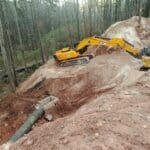State of Tennessee
Tennessee Stormwater Laws & Regulations
The State of Tennessee operates under the National Pollutant Discharge Elimination System (NPDES) program under the authorization of the U.S. Environmental Protection Agency (EPA) through state regulation TDEC Rule Chapter 0400-40-01, 03, 04 and 05. The Tennessee Division of Water Resources manages the permitting and compliance of stormwater discharge.
EXCERPT-Tennessee NPDES Permit
Who Needs An NPDES Discharge Permit?
Persons discharging pollutants directly from point sources into surface waters of the state must obtain an NPDES discharge permit from the Tennessee Division of Water Resources. Direct dischargers include industrial and commercial wastewater, industrial stormwater, and municipal wastewater discharges. Mining facilities and Class I Concentrated Animal Feeding Operations (CAFOs) also require NPDES discharge permits.
Industries sending wastewater to public sewers, called publicly owned treatment works (POTW), are considered indirect dischargers, and they do not need an NPDES discharge permit. However, these industries must obtain a discharge permit from their local POTW. POTW standards and requirements are specified in local sewer ordinances. Industries that discharge to a POTW must contact their municipality to obtain a discharge permit.
Plans for treatment works may have to be prepared by an engineer licensed in the state of Tennessee. Plans must be approved by the Division of Water Resources prior to construction.
What Information Must I Provide?
Applicants must submit application forms 180 days before (1) they plan to initiate a new discharge, (2) their existing discharge permit expires, or (3) they make a significant modification to the quantity of discharge or the nature of pollutants in an existing discharge. The following forms are required:
- General Information – EPA Application Form 1. This form is required of all NPDES permit applicants. The form requires general facility information such as the name, address and telephone number of the facility and contact person; Standard Industrial Classification codes and nature of the business; operator information; existing environmental permits; and a topographic map of the area extending at least one mile beyond property lines.
- Wastewater Discharge Information – EPA Application Form 2C. This form is for existing manufacturing, commercial, mining, and silvicultural operations. The form requires information concerning the flows, source of pollution and treatment technologies; production and improvements to reduce pollutants in the discharge; intake and effluent characteristics; potential discharges not covered by the analysis; biological toxicity testing data; and contract analysis information.
- New Sources and New Dischargers: Application for Permit to Discharge Process Wastewater – EPA Application Form 2D.This form is required of all new dischargers. The form requires information concerning outfall location; discharge date; flows, sources of pollution and treatment technologies; production of the effluent; effluent characteristics; and an engineering report on the wastewater treatment.
- Facilities Which Do Not Discharge Process Wastewater – EPA Application Form 2E. This form is for facilities that discharge only non-process wastewater (e.g., discharges of sanitary wastes and noncontact cooling water). The form requires information concerning the receiving waters, discharge date, type of waste, effluent characteristics, an indication of whether the discharge will be intermittent or seasonal and the treatment system.
- Application for Permit to Discharge Storm Water Associated With Industrial Activity – EPA Application Form 2F. This form is available for applicants who are not eligible for coverage by an NPDES Tennessee Stormwater Multi-Sector General Permit and whose discharge is composed entirely of stormwater. Form 2F is also available to dischargers who choose to be covered under an individual permit rather than a general permit. The form requires outfall location information, a narrative description of pollutant sources, a site drainage map, information on significant leaks or spills, discharge information, biological toxicity testing data, existing best management practices, and certification that the discharge contains only stormwater.
- Form CN-1090is required to identify the parties responsible for different aspects of the permit.
In most cases, topographic maps, process flow line diagrams, and extensive sampling data are required with the applications. A preliminary engineering report and treatability analysis also may be required where unusual or complex wastewater treatment systems may be needed.
What Are The Division’s Rights And Responsibilities After The Permit Is Issued?
The Division of Water Resources has the responsibility to take all prudent steps to secure, protect and preserve the waters of Tennessee.
The Division and the EPA have the right to enter and inspect the facility and all related records at any reasonable time. They also may inspect any related equipment or monitoring methods. The Division has the right to revoke, suspend or modify any permit for violation of permit conditions.
EXCERPT- Tennessee Qualifying Local Program
The Phase II stormwater regulations include provisions allowing for streamlining and coordination among programs at the state and local levels. This is true for the regulation of construction site runoff. The qualifying local program provision for the management and oversight of stormwater runoff from construction activities allows for this streamlining. Under this provision, the State of Tennessee, which has been delegated NPDES authority, can formally recognize a municipal program that meets or exceeds the provisions of its own construction general permit. When this occurs, a permitee, responsible for a project within the jurisdiction of a recognized municipality, would follow that municipality’s requirements for stormwater management.
Per CFR 122.44(s), the Division of Water Resources can formally recognize a regulated Municipal Separate Storm Sewer System (MS4) as a QLP that has been shown to meet or exceed the provisions of the General NPDES Permit for Discharges of Stormwater Associated with Construction Activities (CGP). If a construction site has submitted a program specific Notice of Intent (NOI) to a participating QLP, and has obtained a Notice of Coverage (NOC), the operator of the construction activity is authorized to discharge under the CGP without the submittal of an NOI, Stormwater Pollution Prevention Plan (SWPPP), or related permit fee to the division.
Current Tennessee QLP Participants:
- Bristol
- Cleveland
- Kingsport
- Cookeville
- Franklin
- Knoxville
- Washington Co.
SUPPLEMENTAL DOCUMENTS:
NPDES Stormwater Permitting Program
Tennessee Permanent Stormwater Management and Design Guidance Manual
Tennessee Qualifying Local Program

 Kenosha, Wis. Highway KR Regenerative Stormwater ConveyanceThe Root-Pike Watershed Initiative Network Kenosha County, and others worked with AQUALIS to design and implement an innovative solution for stormwater control along Highway KR.
Kenosha, Wis. Highway KR Regenerative Stormwater ConveyanceThe Root-Pike Watershed Initiative Network Kenosha County, and others worked with AQUALIS to design and implement an innovative solution for stormwater control along Highway KR. Durham, N.C. Sinkhole Leads to Stormwater System RehabilitationThe tenant on this property noticed a depression that opened to the ground below and notified the property owners.
Durham, N.C. Sinkhole Leads to Stormwater System RehabilitationThe tenant on this property noticed a depression that opened to the ground below and notified the property owners.

